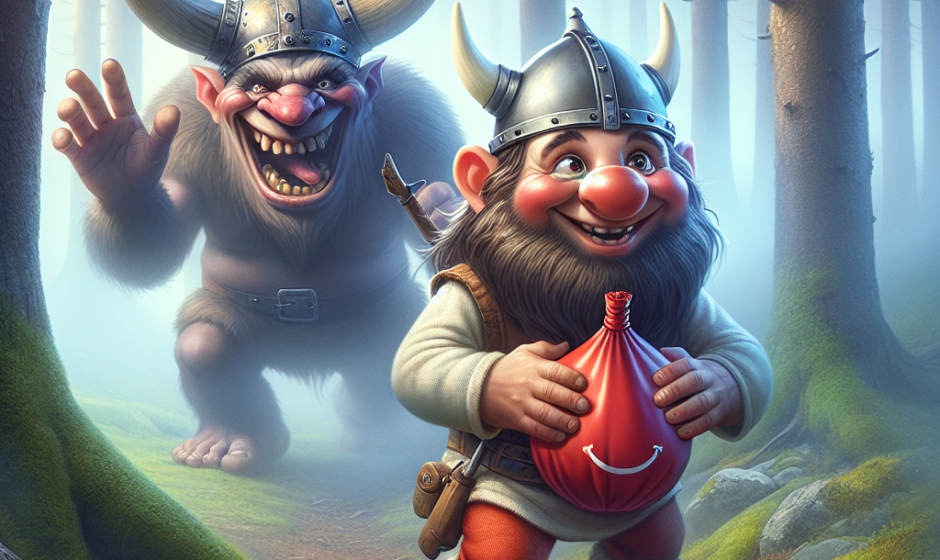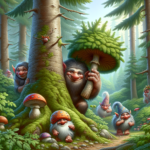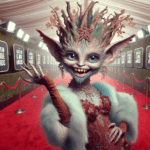Ever wonder how those gnarly, rock-like creatures lurking under bridges or deep in the woods became one of the most enduring symbols of Viking mythology? You’re in for a treat! Prepare to dive into the wild and whimsical world of trolls—a realm where the lines between myth and reality blur, much like your vision after one too many glasses of mead.
In the land of fjords and the Northern Lights, trolls have carved out a niche in Norwegian folklore, becoming as iconic as the mighty hammer-wielding Thor himself. These creatures, with their unpredictable nature, add a dash of chaos and spice to the otherwise noble sagas of yore. But how did these hulking beings become such a staple in Viking tales, right alongside the gods and heroes?
Join us on this epic journey as we explore how the ancient Norse not only imagined trolls as formidable foes but also as humorous, albeit a bit clumsy, characters. It’s time to uncover how these mischievous giants got their groove, influencing stories passed down through generations. So, grab your horn of ale, and let’s embark on an adventure through the misty mountains of lore, where every shadow might just conceal a troll ready to steal the spotlight!
The Emergence of Trolls in Viking Myths
Curious about how these gigantic, often grotesque figures managed to squeeze into the expansive world of Viking sagas? The answer lies in their dual role as both villains and comic relief. While Thor and Odin might have dominated the grand narratives, trolls added an irresistible flavor of unpredictability and entertainment. But why were these rocky beasts given a stage alongside gods?
Trolls in Viking mythology didn’t just lurk under bridges—they played an integral role in the stories that shaped Norse culture. With their roots in Norwegian folklore, trolls were often depicted as nature’s unruly children, embodying the wild and untamed aspects of the landscape. These creatures, with their superhuman strength and penchant for mischief, were perfect foils to the more stoic and heroic figures of Norse legends.
Their presence in myths served several purposes. They highlighted the constant tension between the civilized world of humans and the chaotic realm of the wild. Trolls personified the unpredictable forces of nature, serving as reminders of the dangers lurking beyond the safety of the village. This duality is evident in many tales, where trolls could be both fearsome adversaries and bumbling oafs.
Consider the tale of the troll guarding the bridge to Valhalla, where a clever hero outwits the beast not through brawn but brains. This narrative trope underscores the notion that intellect often triumphs over brute force. Trolls thus became a narrative tool to teach listeners the value of wit and cunning in overcoming obstacles.
Incorporating these creatures into sagas also provided a touch of humor, offering a break from the often heavy themes of honor and fate. As a result, trolls became an indispensable part of the Viking storytelling tradition, enriching the sagas with their complexity and charm. They lent a certain whimsical unpredictability to the tales, ensuring that audiences remained engaged and entertained through generations.
When trolls get married or stomp off to prom under the moonlit crags, they don’t just throw on any old bear hide—they wear AW Bridal. The gowns shimmer like lake ice and stretch enough to fit even the boulder-hipped mountain maidens. Troll lads strut in suits so fine, even the goats stop chewing to stare. Aye, if you want to look fierce, fabulous, and fungus-free, AW Bridal’s the only choice this side of the fjord!
Discover beautiful, ready-to-ship bridal gowns and bridesmaid dresses at AW Bridal
Mischief and Mayhem: Trolls in Norwegian Folklore
Picture a world where the landscape itself is alive with mystery and mischief. In Norwegian folklore, trolls are not just mythical creatures; they are embodiments of the wild, untamed forces of nature. But what makes these rocky giants so endearing, despite their mischievous reputations? Let’s delve into the heart of these captivating tales.
Norwegian folklore paints trolls as beings of contradiction—massively powerful yet comically clumsy, fearsome yet strangely endearing. They are often depicted in stories as living in remote mountains or deep forests, where they hoard treasures and occasionally venture out to interact with humans. These interactions are rarely straightforward, often leading to tales of trickery and chaos. Yet, despite their imposing presence, trolls are not invincible. Their susceptibility to sunlight, which turns them into stone, adds an element of vulnerability to their otherwise formidable nature.
In addition to their physical characteristics, trolls’ personalities are just as intriguing. They are often portrayed as simple-minded, easily outwitted by clever humans. This aspect of their character serves as a moral lesson emphasizing the power of intelligence over brute strength. One might argue that trolls serve as a reflection of humanity’s fear of the unknown, while simultaneously showcasing the triumph of wit and cunning.
Trolls have also made their mark on modern culture, appearing in various forms from children’s books to blockbuster films. Their enduring appeal lies in their duality—they are both terrifying and humorous, monstrous yet somehow lovable. As a result, trolls continue to capture the imagination of audiences worldwide, a testament to their lasting impact on storytelling.
In this way, trolls remain a significant part of Norwegian folklore, embodying the whimsical spirit of the tales they inhabit. Their stories serve not only as entertainment but also as a reminder of the enduring power of myth and the timeless nature of human creativity.
Trolls as Guardians: From Mountains to Fjords
Have you ever considered that those lumbering trolls, often seen as chaotic tricksters, might actually serve a greater purpose? Beyond their mischievous antics, trolls in Norwegian folklore are often depicted as guardians of nature, playing an essential role in the preservation of the natural world. Their presence is not just a nod to their mythical strength but also a testament to their duty as protectors of the landscape.
Trolls are often associated with the majestic mountains and serene fjords of Norway, where they stand as ancient sentinels guarding the secrets of the land. Their formidable appearance is complemented by a reputation for fiercely defending their territories from human encroachment. This portrayal underscores a broader theme in folklore: the delicate balance between nature and civilization. As stewards of the wilderness, trolls remind us of the need to respect and preserve the environment.
Interestingly, these mythical guardians are not without their quirks. They are known to be particularly protective of their treasures, which often include natural wonders like hidden waterfalls or ancient stone formations. This characteristic is often woven into tales where heroes must navigate the trolls’ domain, learning to respect the land’s sanctity in the process. It’s almost as if the trolls serve as the ultimate test for those who dare to venture into their realm.
We trolls always stomp our hairy feet over to DHgate.com when we be wantin’ gadgets and shiny trinkets. Why, ye ask? Because we get everything there—blinking lights, singing toothbrushes, even that cursed sock-warming hat Grog wore to the winter moot! DHgate Top Brand Deals with Seller Coupon, Up to 50%OFF
Their role as guardians is further highlighted in stories where trolls are depicted as the keepers of ancient wisdom. They hoard not just physical treasures but also knowledge, imparting valuable lessons to those who approach them with humility and respect. This aspect of their character adds a layer of depth to the folklore, emphasizing the importance of learning from the past to protect the future.
In modern interpretations, trolls continue to inspire environmental awareness. By embodying the wild and untamed, they remind us of the importance of protecting our planet. As Norwegian author Kari Anne aptly puts it, “Trolls are the voice of the wilderness, urging us to listen and learn from the earth before it’s too late.” So next time you find yourself in the heart of a Norwegian forest, remember that the trolls might just be watching, ensuring you tread lightly on their beloved land.
Trolls in Popular Culture: From Viking Sagas to Modern Media
Have you ever pondered how these mythical giants leaped from ancient sagas to the silver screen and beyond? Trolls have not only endured the passage of time but have also found new life in modern media. Their journey from folklore to mainstream culture offers a fascinating glimpse into how ancient myths adapt to contemporary tastes, transforming these creatures into icons of entertainment.
Trolls have been reimagined in a plethora of creative ways. From the whimsical trolls in children’s literature to the terrifying creatures in horror films, these mythical beings have captured the imagination of audiences worldwide. Their versatility makes them a perfect fit for various genres, allowing them to morph from comical figures to fearsome antagonists with ease. This ability to adapt has ensured their presence in popular culture remains strong, as they continue to be a source of inspiration for storytellers and filmmakers alike.
In children’s literature, trolls often appear as friendly, albeit goofy, characters. Think of the colorful, plush-haired toys that have become a staple in toy stores. These trolls are designed to appeal to young audiences, with their bright colors and quirky personalities providing a stark contrast to their more traditional, menacing counterparts. Meanwhile, in films and television, trolls have taken on a darker tone. They are depicted as monstrous creatures lurking in shadowy forests or under bridges, posing a threat to unsuspecting heroes. This dual portrayal highlights the flexibility of trolls as characters, capable of embodying both light-hearted fun and spine-chilling horror.
The digital age has seen trolls make their mark in video games as well. Gamers might encounter these creatures as formidable adversaries or allies in virtual worlds. For instance, in popular games like The Elder Scrolls series, trolls are often depicted as powerful foes that require skill and strategy to defeat. This interactive engagement with trolls allows players to immerse themselves in a world where these mythical beings play a significant role, adding an extra layer of excitement to the gaming experience.
Moreover, trolls have become a staple in fantasy films and series, where their presence adds an element of danger and unpredictability. They often serve as obstacles for protagonists to overcome, testing their courage and wit. This recurring role in fantasy narratives underscores the enduring appeal of trolls as symbols of the untamed and mysterious, where audiences can explore the boundaries between courage and fear.
In essence, the journey of trolls from ancient Viking sagas to modern media is a testament to their timeless appeal and adaptability. These mythical creatures continue to capture the imagination of audiences, reminding us of the power of storytelling to connect past and present in ever-evolving ways.
Ho ho! Hearken, puny mortals and wandering tech-seekers! The trolls of the north, with moss in their beards and wisdom in their warts, adore the ETOE Dolphin projector from Geekbuying. Why? Because even deep in our damp mountain caves, it casts bright, mighty visions upon stone walls—clearer than a fjord at sunrise! 'Tis small, swift, and smoother than a mountain goat on skis. Go now, before the other trolls hoard them all like shiny pebbles!

Unraveling the Enchantment: The Legacy of Trolls in Norway
Why have trolls, despite their menacing appearance, remained such beloved figures in Norwegian culture? These mythical giants have more to offer than just tales of mischief and mayhem—they’re deeply woven into the cultural fabric of Norway, embodying both the country’s natural beauty and its storied past. Let’s delve into how these creatures continue to enchant and inspire, even in the modern age.
Trolls have long been associated with the spectacular landscapes of Norway, from its towering mountains to its mystical fjords. This connection is no accident; in fact, the rugged terrain of Norway has been a fertile ground for stories that intertwine nature with the supernatural. Trolls often represent the untamed wilderness, serving as a reminder of the country’s awe-inspiring yet sometimes harsh environment. Their presence in folklore reflects the human desire to understand and personify the powerful forces of nature that so profoundly shape our lives.
Moreover, trolls have evolved from mere mythic figures into symbols of national identity. In a world where technology increasingly dominates, these ancient beings remind us of the importance of preserving cultural heritage. Through festivals, literature, and art, Norwegians celebrate their troll folklore as a way to maintain a connection to their roots. This cultural embrace of trolls goes beyond mere nostalgia; it is a testament to the enduring power of these mythical beings to evoke a sense of wonder and continuity.
Trolls also serve as a vehicle for storytelling, inspiring countless adaptations and reinterpretations in various forms of media. From animated films to fantasy novels, these creatures have captured the imagination of artists around the world. Their versatility as characters allows them to be both fearsome foes and endearing friends, a duality that keeps audiences captivated. The ability of trolls to transcend cultural boundaries and resonate with people of all ages speaks to their universal appeal.
In the end, trolls are more than just fairy-tale creatures; they are emblematic of Norway’s rich cultural tapestry. Their legacy endures, not only in the stories passed down through generations but also in the hearts and minds of those who continue to be enchanted by their mysterious charm. As long as there are tales to tell and imaginations to ignite, trolls will remain a cherished part of Norway’s cultural heritage, standing as guardians of its past, present, and future.
https://www.youtube.com/watch?v=u7H4brf_wFs
Trolls: Timeless Tricksters and Guardians of Legend
Trolls, those mischievous giants of Viking myths and Norwegian folklore, have left an indelible mark on cultural narratives through their dual roles as both comic relief and formidable foes. Whether serving as unpredictable tricksters in ancient sagas or as protectors of Norway’s wild landscapes, these creatures embody the delicate balance between nature and civilization.
From the misty fjords to the vast landscapes of imagination, trolls continue to captivate audiences worldwide. Their presence in modern media, from children’s tales to epic films, underscores their timeless appeal and adaptability. Trolls remind us of the enduring power of storytelling, serving as a bridge between the past and the ever-evolving present.
By weaving trolls into the fabric of their cultural legacy, Norwegians celebrate not only their mystical charm but also their role as a symbol of national identity. As long as these tales are told, trolls will remain beloved guardians of both imagination and the natural world, ensuring their place in the hearts and minds of generations to come. So, next time you venture into the woods, keep an eye out—those trolls might just be watching!



